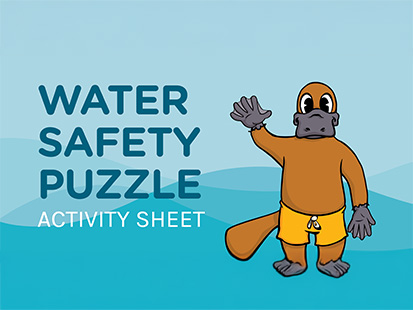Water safety skills are an essential part of every swimming lesson at Kingswim. Continue your child's water safety education at home with our fun activities!
Water safety puzzle
Can you find the missing words that keep you safe around the water?
Download our crossword puzzle and see if you can find the correct answers.

Water safety quiz: Safety at the beach
During the warmer months, you may spend more time at the beach with your family and friends swimming and surfing in the waves or playing in the sand.
But do you know how to stay safe?
Test your knowledge of how you, your family, or friends can stay safer at the beach with our quiz. Can you get 100%?
Play the quiz
Click on each question below to reveal the answers!
-
Starting with 'S', what five things can you do to stay safe in the sun?
- Slip on a shirt
- Slop on some sunscreen
- Slap on a hat
- Seek some shade
- Slide on some sunglasses
-
Fill in the blank: Always swim between the _ and _ flags at the beach
Red, yellow
-
What are the three steps to follow if you get caught in a rip?
Step 1: Stay calm and float
Step 2: Raise one arm in the air with an open hand
Step 3: Call for help! -
What are three ways you can stay afloat in water without an aid?
Sculling, treading water, or floating.
-
Complete the names of these creatures you may encounter at the beach: sting _, _ bottle, blue-ringed _
Ray, blue, octopus.
-
What does PFD stand for?
Personal Flotation Device
-
What is one of the three survival strokes?
Survival backstroke
Breaststroke
Sidestroke
-
True or false: You can identify a rip by whether waves are breaking either side of it
True!
-
What is the difference between a lifesaver and a lifeguard?
A lifesaver is a volunteer and a lifeguard is paid, however their role is the same.
-
Fill in the blank: Never swim _
Alone
Looking for more water safety activities for preschoolers?
Kingswim provides a free water safety program at early learning centres and kindergartens in our communities. Filled with fun activities, the incursion teaches water safety concepts and practical skills to children aged two to five years.
Discover our water safety program
Other fun activities for kids
Check out these fun facts about swimming to learn something new and impress your swimming buddies.
You might also like to try these pool games for kids – don't forget about water safety while playing!
